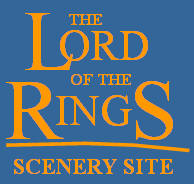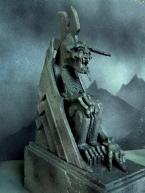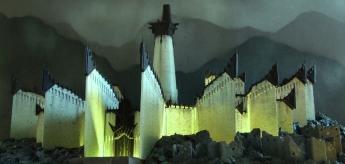|
The Making of the Black Gate
© Lotrscenerybuilder 2009
_small.jpg)
Sam: "That's it, then.
It can't pass for the Weta gate any longer!"
Our first version of the Black Gate dates from December 2004. It took us three
evenings to construct the miniature, rocks & all. We had not yet discovered MDF as a
building material; instead, we used a few dozens of wooden clothes-pegs to imitate the
maladjusted fallals of Mordorish architecture. We were hugely impressed by the
outcome. But, as time went by, its scenic shortcomings became more and more painful to
the Eye.
In the fall of 2008 we were searching Middle-earth for a suitable building project in
order to make a serious DIY-kit out of it. Remembering the simplicity of our former
gate we pondered about building a second version, more faithful to the movie-image. We
fancied a week or two would suffice to design, build and finish the miniature.
_small.jpg)
We aimed for an optimal level of resemblance. At the same time we wanted to make
sure that the model could be reproduced by fellow terrain makers with only marginal
need of materials, tools and - most important - hobby-skills. In the end we confined
ourselves to the use of only two different thicknesses of MDF plate, along with
ordinary sheets of cardboard. Apart from that, cocktail-sticks were going to
be used to give shape to the echinodermic nature of the gate.
Usually, a LSB building process proceeds upon a rather casual scheme: there's rarely a
clear plan of campaign, we just start to produce element no. 1, followed by no. 2, no. 3
and so on… our models do tend to grow like a coral reef - with lots of devilfish popping
up everywhere to try our patience! This time however, we had to bear in mind that we
were going to write a DIY-manual at some stage, with step-by-step pictures & full-sized
templates.
_small.jpg)
The Black Gate is a symmetrical structure with two identical halves. We decided to
build the right wing first, without worrying too much about the upcoming manual. Only
when we had a clear idea of all the aspects of the structure, we would turn to the other
half. But of course we had to keep a record of the individual steps. To speed up things
we copied every element hot from the fretsaw and added notes about their dimensions.
It took over a month to complete the right wing. The bulk of the time went into cutting
teeny-weeny elements: strips, hooks, fangs, spikes, teeth… Like the old one, the
updated version proved to be a fairly straight-forward model to build. Notwithstanding
its complicated appearance there's actually a single vertical design that is repeating
itself ad infinitum (if this phrase doesn't make sense to you, build your own gate - you
will get the point).
_small.jpg)
Because it's a bit of a problem to have these 'Big-atures' permanently on show we try to
photograph them to advantage. We were happy with this picture because it gave us an
inkling of what the scenery was going to look like in the end. At this stage the rocky
slopes were still lacking and the walls were only sprayed with flat black paint which
made the gate looking a bit dull.
_small.jpg)
The model had to be useable for playing (massive!) battle games. The gate isn't exactly
towering above the GW-miniatures but it still stands about 4inches / 10cm tall. There's
ample space for a regiment of Morannon Orc Bowmen on the gangway behind the
battlements; Orc Captains can shout their orders - in Black Speech - from the hinge-
towers. The height of the watchtowers on the flanks comes to 20inches / 50cm; a
comfortable altitude for the Mordor Guards to spy out the desolation of Dagorlad…
_small.jpg)
"An hour of wolves and shattered shields
when the age of Men comes crashing down!"
But of course The Great Battles Of Our Time are going to be settled in front of the
gate, on the ash plain between the slag mounds. Once finished, our gaming board
measured nearly 1,500 square inches / 10,000cm2 of battle turf; more than enough to
deploy an overwhelming Mordor host against King Elessar's petty force - including a
Panzergruppe of Műmakil.
_small.jpg)
As for the scale: here's Gandalf again posing in front of the gate. It might not
entirely agree with the dimensions of the real thing but it's big enough to become a real
nuisance in the living room. And trolls can easily hide themselves behind the doors, with
room to spare.
_small.jpg)
Building the left wing of the gate took considerably more time than the first half did.
This was due to the fact that, now, we had to produce and test all templates as well.
We even used some of them on our own miniature, to make sure that they performed well.
It still surprises us to see how the architecture of Middle-earth often looks very casual
if not disorderly, while, at the same time, the building plans are always very strict and
rigorously geometrical.
_small.jpg)
It's hardly possible for the untrained eye to discern the polychrome palette that is
applied onto our models. But we do use different colours: Orc Black, Orc Grey, Orc
White, Orc Green, Orc brown… The result is a nondescript ash-tinted finish which
seems to match perfectly with the gloomy atmosphere on the screen. We love to use it
on all our miniatures - with the exception of our Shire models which have a more
cheerful colour bouquet (but even there you'd be surprised to learn how many cans of
black & grey paint we used on them!).
According to Karen Wynn Fonstad's Atlas of Middle-earth, the tower above is Carchost,
the "Fang Fort". The rocks and walls on the picture are only basecoated with anthracite
paint. In search of optimal lighting we took a series of pics to test the shadows for
dramatic effects.
_small.jpg)
… And the other one: Narchost, the "Fire-tooth". A pleasant side issue of working on
these Middle-earth monuments is that it gives you a deeper understanding of their
architecture and history - or so we believe. As for the Black Gate, the artwork of John
Howe and the comments of Alex Funke and Richard Taylor in the Appendices are very
informative. Also, the choices of Weta in relation to the texts of Tolkien suddenly make
more sense. The towers were built by the Gondorians to keep their enemies inside
Mordor: hence the brickwork of their bases. The actual gate and the passage-walls to
the towers were built out of iron by Sauron's minions. The same goes probably for the
upper part of the towers: it's all rivets and steel plating there (just watch these
pinnacles breaking off their stone pedestals and crashing into the abyss when the Ring
is destroyed).
_small.jpg)
Anyway, it took us three months to complete the whole set. One could say we slightly
miscalculated the amount of work to be done on this miniature… The sting is always in
the tail: the surrounding landscape and the painted background are 'buildings' in their
own right; they do take their share of construction time. And it's no good hurrying up
things. If, for example, you don't get these rocky slopes right, it will make your walls
look like a hoarding on a rubbish dump.
_small.jpg)
Now we'd like to end this article with a daring new theory about the origins of Mordor.
As you probably know, its genesis is rather obscure. The Silmarillion tells us about the
existence, during the First Age, of the Inland Sea of Helcar in the region east of Ered
Nimrais. The history of Mordor actually commences about the Year 1000 of the Second
Age with Sauron taking refuge in the Land of Shadow and building Barad-dűr. Karen
Wynn Fonstad explains: "Although no texts supports my conclusions, Mordor might have
appeared as part of a worldwide upheaval during the destruction of the Iron Mountains
in the area where the Great Gulf partially drained the Inland Sea - the volcanic
processes in the formation of that land would allow relatively rapid mountain-building
processes."
(From: "The Atlas of Tolkien's Middle-earth", page 37)
It might have been like that - who lives to tell? We can only speak from our own
experiences, for what it's worth. All right, out with it: we think that, in the very
beginning, Mordor might have looked like this:
_small.jpg)
But again, it's purely hypothetical. We have to go back to find out for sure…
"And then he saw, rising black,
blacker and darker than the vast shades amid which it stood…"
The Black Gate Opens
|




_small.jpg)
_small.jpg)
_small.jpg)
_small.jpg)
_small.jpg)
_small.jpg)
_small.jpg)
_small.jpg)
_small.jpg)
_small.jpg)
_small.jpg)
_small.jpg)
_small.jpg)